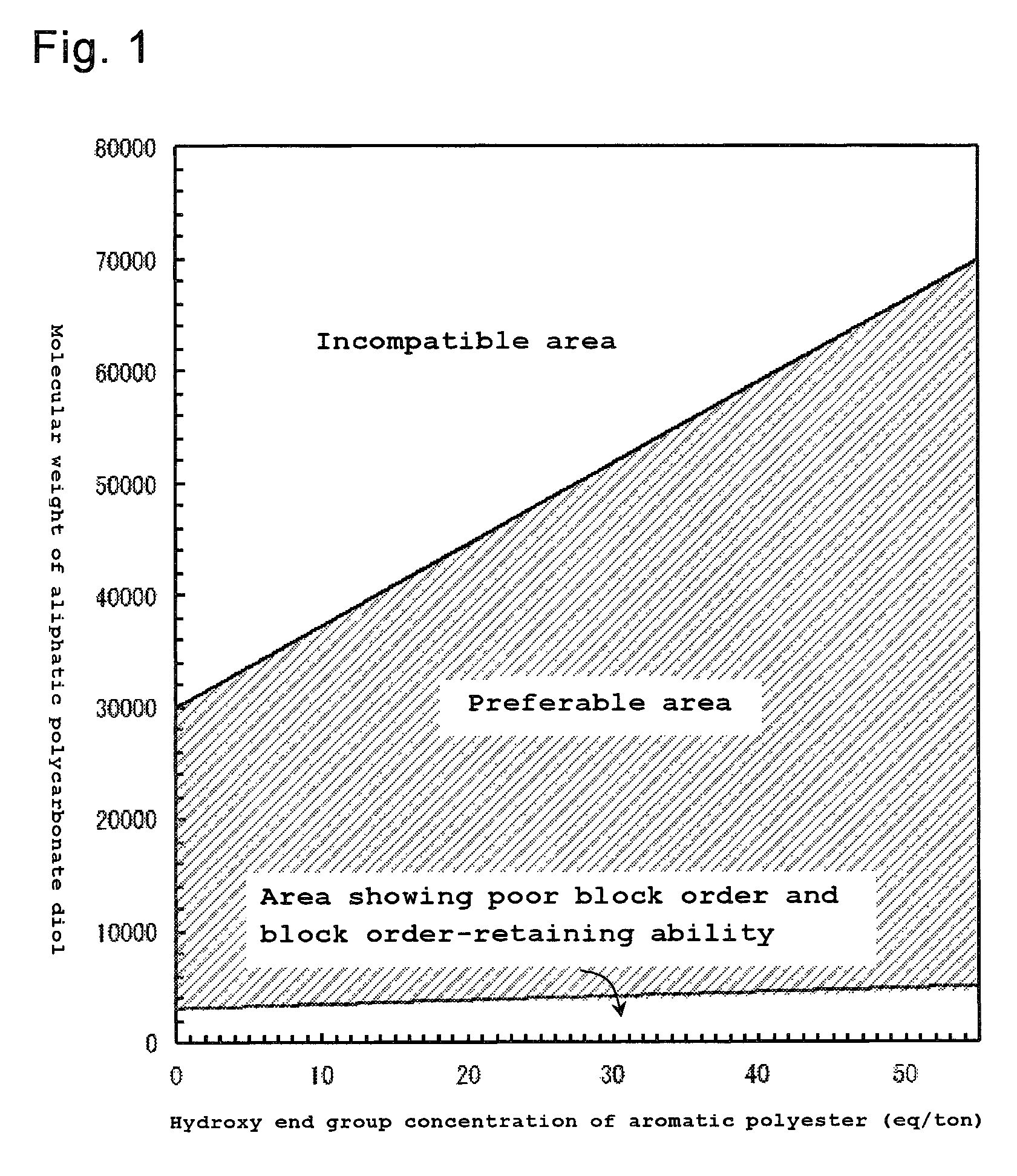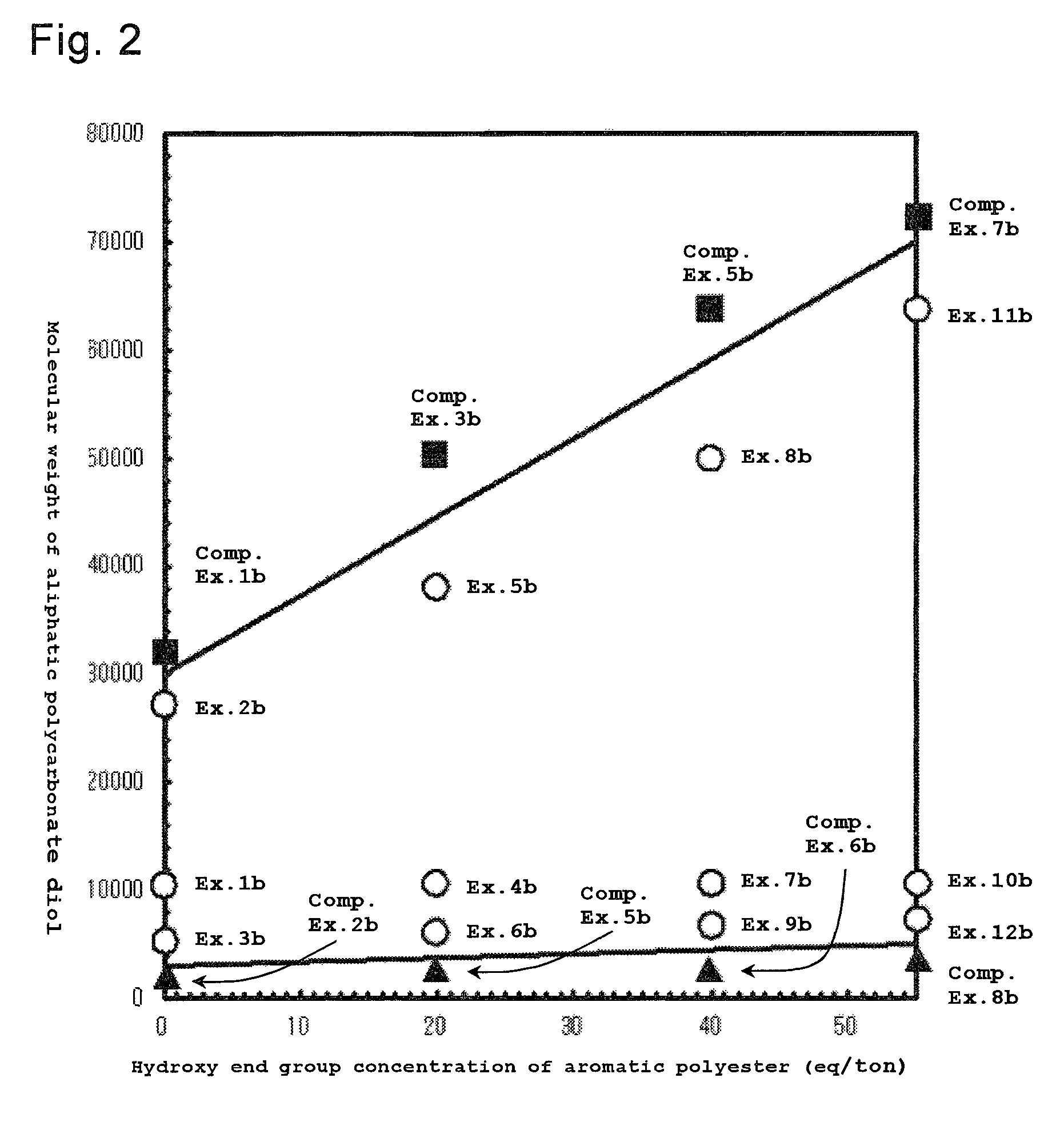Method for producing thermoplastic polyester elastomer, thermoplastic polyester elastomer composition, and thermoplastic polyester elastomer
a technology of thermoplastic polyester and composition, which is applied in the field their composition, and the production of thermoplastic polyester elastomers, can solve the problems of poor block order, poor heat aging resistance, poor water resistance and low-temperature properties of obtained polyester polycarbonate-type elastomers, etc., to improve block order and block order-retaining ability, good heat resistance, and good heat resistance. , the effect of improving the block order and the effect o
- Summary
- Abstract
- Description
- Claims
- Application Information
AI Technical Summary
Benefits of technology
Problems solved by technology
Method used
Image
Examples
example 1
[0174]One hundred parts by weight of polybutylene terephthalate (PBT) having a number-average molecular weight of 30000 and 43 parts by weight of the polycarbonate diol having a number-average molecular weight of 10000 prepared by the above method were stirred at 230-245° C., at 130 Pa for 1 hour. When it was confirmed resin became transparent, the resultant was removed and cooled to obtain Polymer A (thermoplastic polyester elastomer). Physical properties of the obtained polymer were measured and results are listed in Table 1. Polymer A obtained in this Example was good in any properties and had a high quality.
example 2
[0175]One hundred parts by weight of polybutylene terephthalate (PBT) having a number-average molecular weight of 30000 and 43 parts by weight of the polycarbonate diol having a number-average molecular weight of 20000 prepared by the above method were stirred at 230-245° C., at 130 Pa and 1.5 hours. When it was confirmed resin became transparent, the resultant was removed and cooled to obtain Polymer B (thermoplastic polyester elastomer). Physical properties of the obtained polymer were measured and results are listed in Table 1. Polymer B obtained in this Example had a high quality equivalent to the quality of thermoplastic polyester elastomer obtained in Example 1.
example 3
[0176]One hundred parts by weight of polybutylene terephthalate (PBT) having a number-average molecular weight of 30000 and 43 parts by weight of the aliphatic copolycarbonate diol having a number-average molecular weight of 10000 prepared by the above method were stirred at 230-245° C., at 130 Pa and for 1 hours. When it was confirmed resin became transparent, the resultant was removed and cooled to obtain Polymer C (thermoplastic polyester elastomer). Physical properties of the obtained polymer were measured and results are listed in Table 1.
[0177]Polymer C obtained in this Example had a high quality equivalent to the quality of the thermoplastic polyester elastomer obtained in Example 1. Comparing to a case where polycarbonate diol comprising 1,6-hexanediol was used as a soft segment, it was more excellent in low-temperature properties.
PUM
| Property | Measurement | Unit |
|---|---|---|
| tensile strength at break | aaaaa | aaaaa |
| melting point | aaaaa | aaaaa |
| temperature | aaaaa | aaaaa |
Abstract
Description
Claims
Application Information
 Login to View More
Login to View More - R&D
- Intellectual Property
- Life Sciences
- Materials
- Tech Scout
- Unparalleled Data Quality
- Higher Quality Content
- 60% Fewer Hallucinations
Browse by: Latest US Patents, China's latest patents, Technical Efficacy Thesaurus, Application Domain, Technology Topic, Popular Technical Reports.
© 2025 PatSnap. All rights reserved.Legal|Privacy policy|Modern Slavery Act Transparency Statement|Sitemap|About US| Contact US: help@patsnap.com


